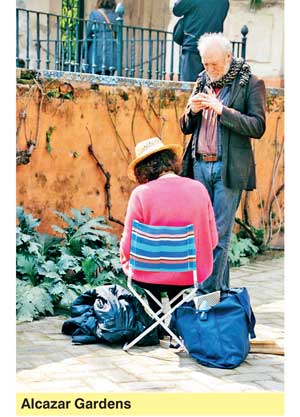Wednesday Apr 24, 2024
Wednesday Apr 24, 2024
Saturday, 17 June 2017 00:06 - - {{hitsCtrl.values.hits}}
By Aysha Maryam Cassim
A holiday in Spain is as deliciously diverse as it can get. From Catalonia to Andalusia, there’s a vibrant sangria of delights woven into its tapestry of civilisations.
Seville, the flamboyant Andalusian capital, is more palatable for the culturally-curious tourist. If you love the Mediterranean sun and are willing to walk a few extra miles, this is the perfect, laid-back, romantic, Andalusian getaway for you.
Today, when I look at my worn-out city map of Seville, it takes me back on a transient journey to this amazing city on the path I followed from Iglesia de Santa Catalina to Torre del Oro – Tower of Gold.
Seville has a rich Moorish heritage and plenty of Spanish flair for tourists to indulge in. The legends say that Seville was founded by Hercules and flourished during the Tharsis reign.
Situated on the banks of the Quadalquivir River, this town was once a prosperous port that carried out the trade with the Americans. Today, Seville’s sun-dappled streets are teeming with horse-drawn carriages; tourists ambling down the alleyways and locals lounging beneath the orange trees.
I spent my first day in Seville, visiting the most graceful square in the city, ‘Plaza de España’. Then I headed to ‘Torre Del Oro’, which is located on the Quadalquivir River Bank, to soak up the stunning sunset at the Puente de San Telmo.
The following day, I set out to explore the majority of the must-see sights that are clustered around the cathedral complex; Giralda, Archivo de las Indias and the mighty Palace of Alcazar.

Attractions in Seville
Plaza De España
Often touted as the Venice of Seville, Plaza De Espana is considered one of the most-visited attractions in Andalusia. It is situated inside Maria Luisa Park that is just in front of the University of Seville. The Plaza has served as a movie set in episode II of George Lucas’ ‘Star Wars’ saga ‘Attack of the Clones’ and ‘Lawrence of Arabia’.
The bridges, balustrades and balconies in the square are a fine display of ornate azulejo mosaics, marble work and forged iron decorations. The central building in the semi-elliptical square is flanked by two towers. The square is surrounded by a long canal that is crossed by four bridges, each one representing the four ancient kingdoms of Spain.
Live in a picturesque, fairy-tale moment by renting out a small boat to row in the canal. It’s worth it.
The Metropol Parasol
The waffle-like structure in Plaza de la Encarnacion is an icon of Seville. This contemporary canopy has a stunning sequence of undulating parasols. At present, the square serves as a major urban centre where the locals and tourists gather to indulge once the city comes to life after sundown.
Amidst eclectic bars and restaurants, at the Plaza de la Encarnacion there is an elevated plaza, an archaeological site, and a farmers’ market where you can try Seville’s juiciest olives and other fresh produce.
Los Reales Alcazares – The Royal Palace Fortresses
Built across centuries by a succession of both Muslim and Christian monarchs, The Alcazar of Seville is regarded as one of the outstanding examples of ‘Mudéjar’ architecture. It is the oldest royal palace still in use in Europe.
The Alcazar was built in the 13th century as a fortress and converted into royal residences later. Moors left a distinct mark on Andalusian culture. The Quranic inscriptions and glorious arabesques amidst the gothic edifices render The Alcázar into an enchanting palace in an Arabian tale.
The interior architectural elements provide a thought-provoking glimpse of a graceful Moorish world. The exquisite plasterwork, ceramic tiles with Islamic-inspired geometric motifs, majestic gold ceilings, and patios are some of the mementoes of finest Mudéjar craftsmanship that reminds us of Seville’s early associations of Arabian romance.
The palace was certified as a UNESCO World Heritage site in 1987 for its significance and refinements that belong to a long-ago past.
The Cathedral of Seville
Santa Maria de la Sede in Seville is the largest Gothic cathedral in the world and is recognised as UNESCO World Heritage. Situated in the historical centre of Seville, the astounding sight of the Seville Cathedral it hard to be missed. Its sheer size and Gothic splendour will blow your mind.
Giralda
Giralda is an iconic Moorish tower in Seville. Formerly an Islamic Minaret, this elegant bell tower is a masterpiece of Almohad art, which exemplifies Moorish design with its decoratively arched niches and geometric patterns typical of buildings in Andalusia. You can climb up to the top of the bell chamber for sensational views of the city, especially the Real Alcazar and a bird’s eye view of Cathedral. My Andalusian tour culminated in Seville’s Rio Guadalquivir. I couldn’t have imagined a better way to say Good Bye to Seville than gazing at the beautiful skyline of a unique and incredible city by the banks of a river that once saw Andalucia’s Golden Age.
You can go for a stroll north along the waterfront promenade, watch the colourful kayakers row under Isabelle II bridge or enjoy a relaxing cruise along city’s main Riverland to take in the panoramic views of Seville’s most beautiful and best-known monuments including The Torre del Oro which dominates the banks of river Guadalquivir.